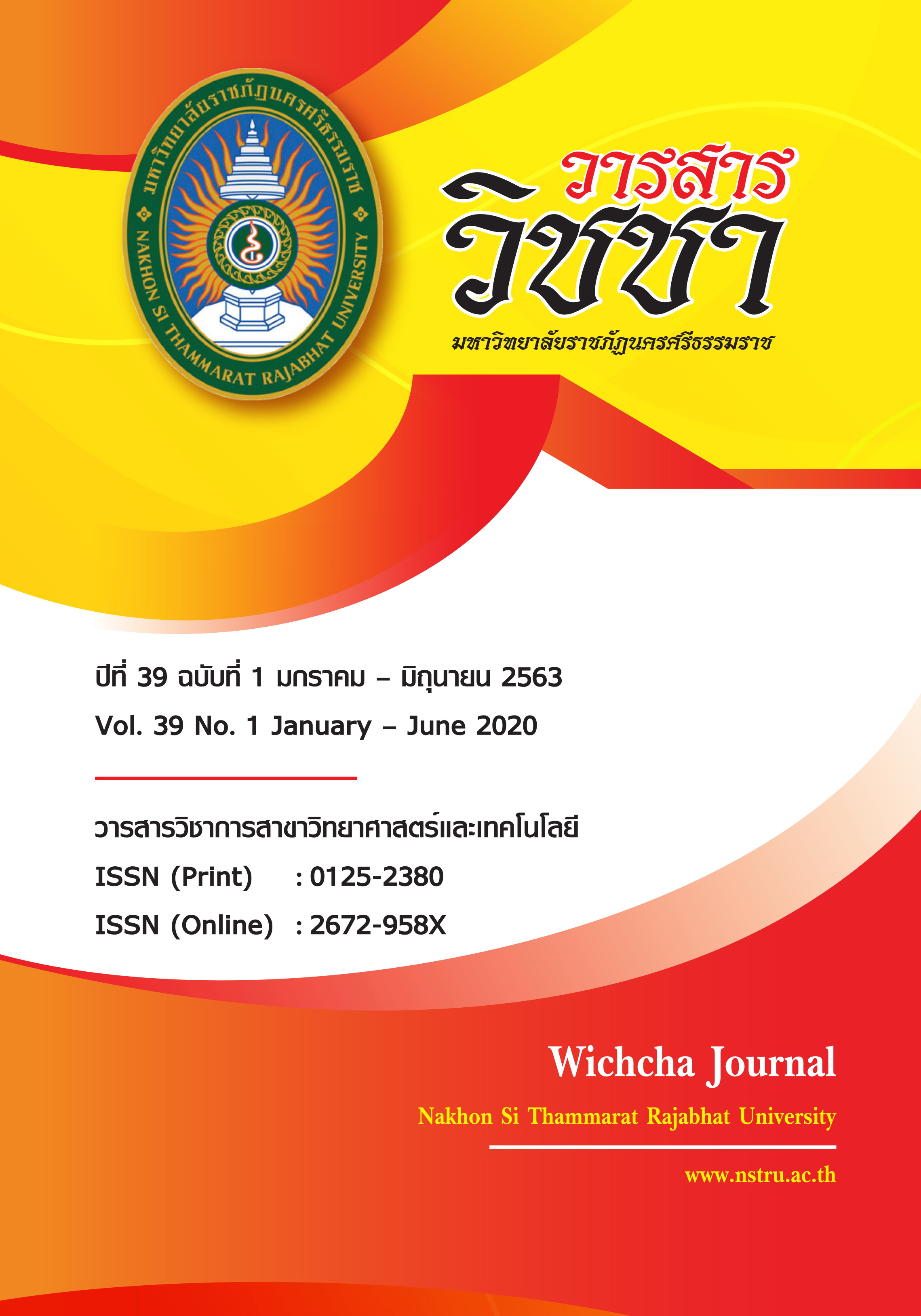Study of Chemical and Microbiological Composition of Kung-Som from Pak Phanang, Nakhon Si Thammarat Using Lactobacillus pentosus L35 as a Fermentation Starter การศึกษาองค์ประกอบทางเคมีและจุลชีววิทยาของกุ้งส้มปากพนัง จังหวัดนครศรีธรรมราช ที่ใช้ Lactobacillus pentosus L35 เป็นกล้าเชื้อในการหมัก
Main Article Content
Abstract
Kung-Som from Pak Phanang is a local food that is popular for consumption and for its health benefits. The objective of this research was to study the chemical and microbiological compositions of the formula of traditional Kung-som and the formula of Kung-som produced by using Lactobacillus pentosus L35 as a fermentation starter. The results showed that L. pentosus L35, or lactic acid bacteria, had a stable growth for about 24 hours. The chemical compositions of traditional Kung-Som and Kung-Som produced by L. pentosus L35 as a starter were found significant differences (p > 0.05) in protein, ash, fat, salt, pH and total acid whereas the moisture was not. Microbial counts during fermentation were found that the total viable count increased at day 5 and decreased at the end of fermentation time (10 days). Total yeast and fungi slightly increased while lactic acid bacteria continually increased until day 10. The microbiological quality of results of Kung-Som showed that the numbers of pathogenic bacteria (Salmonella sp., Staphylococcus aureus, Bacillus cereus, Clostridium perfringens and Escherichia coli) did not exceed the Thai community product standard criteria for Kung-Som.
Article Details
เนื้อหาและข้อมูลในบทความที่ลงตีพิมพ์ในวารสารวิชชา มหาวิทยาลัยราชภัฏนครศรีธรรมราช ถือเป็นข้อคิดเห็นและความรับผิดชอบของผู้เขียนบทความโดยตรง ซึ่งกองบรรณาธิการวารสารไม่จำเป็นต้องเห็นด้วยหรือร่วมรับผิดชอบใด ๆ
บทความ ข้อมูล เนื้อหา รูปภาพ ฯลฯ ที่ได้รับการตีพิมพ์ในวารสารวิชชา มหาวิทยาลัยราชภัฏนครศรีธรรมราช ถือเป็นลิขสิทธ์ของวารสารวิชชา มหาวิทยาลัยราชภัฏนครศรีธรรมราช หากบุคคลหรือหน่วยงานใดต้องการนำข้อมูลทั้งหมดหรือส่วนหนึ่งส่วนใดไปเผยแพร่ต่อหรือเพื่อการกระทำการใด ๆ จะต้องได้รับอนุญาตเป็นลายลักษณ์อักษรจากวารสารวิชชา มหาวิทยาลัยราชภัฏนครศรีธรรมราชก่อนเท่านั้น
The content and information in the article published in Wichcha journal Nakhon Si Thammarat Rajabhat University, It is the opinion and responsibility of the author of the article. The editorial journals do not need to agree. Or share any responsibility.
References
กรมวิทยาศาสตร์การแพทย์. (2558). วิธีมาตรฐานสำหรับวิเคราะห์อาหาร.กรมวิทยาศาสตร์การแพทย์กระทรวงสาธารณสุข. สืบค้นเมื่อ 19 มกราคม 2562 จาก:http://bqsf.dmsc.moph.go.th/bqsfWeb/wp-content/uploads/2017/Publish/e-book/StandardMethodVolumeI.pdf.
จันทิมา คงผอม และฐาปนี จโนภาส. (2560). การตรวจวิเคราะห์คุณภาพทางจุลชีววิทยาเบื้องต้นของกุ้งส้มในพื้นที่จังหวัดนครศรีธรรมราช. รายงานการวิจัย. มหาวิทยาลัยราชภัฏนครศรีธรรมราช.
ชุตินุช สุจริต และไวกูณฐ์ ฤทธิรุฒม์. (2556). การผลิตกุ้งส้มบรรจุในภาชนะปิดที่ผ่านการแปรรูปด้วยความร้อน. รายงานการวิจัย. มหาวิทยาลัยเทคโนโลยีราชมงคลศรีวิชัย.
ณัฐกฤตา ภู่ทับทิม และวนิดา แซ่จึง. (2559). การคัดเลือกแบคทีเรียแลกติกและใช้เป็นต้นเชื้อบริสุทธิ์ในการหมักปลาส้ม. วารสารวิทยาศาสตร์และเทคโนโลยี, 24(6)(ฉบับพิเศษ), 952-967.
ธนากร บำรุงภักดี. (2554). การแยกและจำแนกแบคทีเรียแลคติกจากหน่อไม้ดองเพื่อใช้เป็นเชื้อเริ่มต้นผสมในการหมัก. วิทยานิพนธ์ปริญญามหาบัณฑิต. มหาวิทยาลัยขอนแก่น, ขอนแก่น.
นันธิดา แดงขาว. (2560). กุ้งส้มแบคทีเรียมีชีวิตพิชิตโรค. วารสารวิทยาลัยดุสิตธานี, 11(ฉบับพิเศษ), 356-373.
นิธิยา รัตนาปนนท์. (2554). หลักการวิเคราะห์อาหาร. กรุงเทพมหานคร: สำนักพิมพ์โอเดียนสโตร์.
ปิ่นมณี ขวัญเมือง. (2546). แบคทีเรียกรดแลคติกในผลิตภัณฑ์อาหารหมักดอง. วารสารครุศาสตร์อุตสาหกรรม, 3(1), 62-69.
ผกาวดี เอี่ยมกำแพง. (2559). ผลของเกลือต่อการหมักและยอมรับผลิตภัณฑ์กุ้งจ่อม. วารสารวิชาการพระจอมเกล้าพระนครเหนือ, 26(1), 105-112.
พิทยา ใจคำ และรัชนี แก้วจินดา. (2560) การเปลี่ยนแปลงคุณภาพของปลาส้มในระหว่างการหมักร่วมกับโพรไบโอติก Lactobacillus casei 01 ที่ระดับแตกต่างกัน. วารสารวิจัยและพัฒนาวไลยอลงกรณ์ ในพระบรมราชูปถัมภ์, 12(3), 37-53.
มณฑกานต์ ทองสม. (2560). ประสิทธิภาพการลดคอเลสเตอรอลของแลกติกแอซิดแบคทีเรียที่คัดแยกได้จากอาหารหมักและการประยุกต์ใช้. รายงานผลการวิจัย. มหาวิทยาลัยราชภัฏนครศรีธรรมราช.
วารุณี วารัญญานนท์ บุญถม ธรรมจารีย์ บุหลัน พิทักษ์พล และสุภารัตน์ เรืองมณีไพฑูรย์ (2527). องค์ประกอบทางเคมีของอาหารหมักดองในประเทศไทย. ใน รายงานการประชุมทางวิชาการ มหาวิทยาลัยเกษตรศาสตร์ ครั้งที่ 2 (หน้า 53-76). กรุงเทพ: มหาวิทยาลัยเกษตรศาสตร์.
วิลาวัณย์ เจริญจิระตระกูล. (2536). ผลิตภัณฑ์อาหารหมักจากจุลินทรีย์. สงขลา: คณะวิทยาศาสตร์และเทคโนโลยี มหาวิทยาลัยสงขลานครินทร์.
รินดา ยุ่นฉลาด งามนิจ นนทโส พิกุลทอง ขอเพิ่มทรัพย์ และสุกานดา วิชิตพันธ์. (2548). การเปลี่ยนแปลงประชากรจุลินทรีย์และทางเคมีระหว่างกระบวนการหมักปลาส้มที่เป็นผลิตภัณฑ์ปลาหมักของไทย. วารสารงานวิจัย มหาวิทยาลัยขอนแก่น, 10(3), 188-198.
สำนักงานมาตรฐานผลิตภัณฑ์อุตสาหกรรม. (2548). มาตรฐานผลิตภัณฑ์ชุมชน กุ้งส้ม. สืบค้นเมื่อ 18 มีนาคม 2562 จาก: http://app.tisi.go.th/otop/pdf_file/tcps1032_48.pdf.
AOAC. (2016). Official Methods of Analysis. (20thed). USA: Association of Official Analytical Chemists.
Chaisri, S., Riebroy, S., Utaipattanacheep, A., Chulakarungka, S., Maungteuk, T. and Maneerat, S. (2557). Comparative Studies on Chemical Composition, Proteolysis and Chitin Characteristics of Commercial Kung-som and Kung-jom. In the 52nd Kasetsart University Annual Conference (pp. 472-479). Bangkok: Kasetsart University.
Dangkhaw, N. (2013). Effect of Selected Autochthonous Starter Cultures on Microbial, Chemical and Sensory Characteristics of Kung-Som. Master of science thesis. Prince of Songkla University, Songkla.
Hwanhlem, N., Watthanasakphuban, N., Riebroy, S., Benjakul, S., H-Kittikun, A., Maneerat, S. (2010). Probiotic lactic acid bacteria from Kung-Som: isolation, screening, inhibition of pathogenic bacteria. International Journal of Food & Science Technology, 45(3), 594-601.
Mishra, V.and Prasad, D.N. (2005). Application of in vitro method for selection of Lactobacillus casei strains as potential probiotics. International Journal of Food Microbiology, 103(1), 109-115.
Phithakpol, B., Varanyanond, W., Reungmaneepaitoon, S. and Wood, H. (1995). Plaa-som, Koong-som. In Traditional fermented foods of Thailand. (pp. 22-23). Bangkok: Kasetsart University.
Saraniya, A. and Jeevaratnam, K. (2014). Optimization of nutritional and non-nutritional factors involved for production of antimicrobial compounds from Lactobacillus pentosus SJ65 using response surface methodology. Brazilian Journal of Microbiology, 45(1), 81-88.


